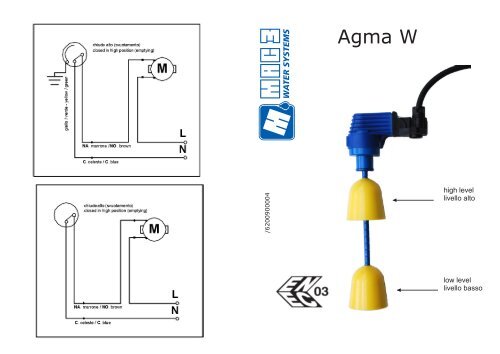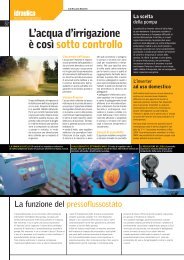Agma W
Agma W
Agma W
Create successful ePaper yourself
Turn your PDF publications into a flip-book with our unique Google optimized e-Paper software.
6200900004<br />
<strong>Agma</strong> W<br />
high level<br />
livello alto<br />
low level<br />
livello basso
<strong>Agma</strong> W<br />
Istruzioni per l’installazione<br />
Il regolatore di livello <strong>Agma</strong> W è un’apparecchiatura di particolare utilità nel caso di utilizzo direttamente su<br />
pompe che devono lavorare su pozzetti molto piccoli, nei quali i normali interruttori a galleggiante non<br />
avrebbero sufficiente spazio per svolgere la loro funzione. Il meccanismo di commutazione è ereditato<br />
dall'<strong>Agma</strong> 22 ed è magnetico. Tale dispositivo è usabile anche in presenza di detriti nell'acqua e nel caso in<br />
cui non sia possibile usare galleggianti a ribaltamento può essere usato anche in presenza di acque sporche,<br />
previa verifica e pulizia periodica dei meccanismi di galleggiamento.<br />
Grazie al tipo di microinterruttore utilizzato, AGMA W è idoneo a comandare pompe fino a 2HP a 230Vca.<br />
Il regolatore è omologato secondo le norme CE EN60730, ed è quindi in accordo con i principali requisiti della<br />
direttiva 93/68/CEE.<br />
Utilizzo: il dispositivo accoppiato ad una pompa consente di regolare il livello del liquido in cui è immerso.<br />
Caratteristiche generali<br />
Contenitore PP atossico - ABS atossico<br />
Caratteristiche microinterruttore 20(8)A 250V~<br />
Temp. di funzionamento 0° ÷ + 50° C<br />
Temp. di immagazzinamento -20°C ÷ + 80° C<br />
Servizio continuo<br />
Grado di protezione camera micro stagna all’immersione<br />
Pressione max utilizzo 0,5 bar<br />
Differenziale min. mm. 50<br />
Differenziale max mm. 150<br />
INSTALLAZIONE<br />
Elettrica. Connettere il dispositivo in serie all'alimentazione della pompa, curando la corretta connessione.<br />
Qualora sia presente il cavo di terra, occorre connetterlo ad un adeguato impianto di terra.<br />
Staccare la corrente dal quadro principale prima di eseguire qualsiasi operazione sul dispositivo.<br />
Idraulica: Bloccare il dispositivo al corpo della pompa o staffarlo ad un supporto adeguato e si raccomanda il<br />
montaggio in posizione verticale (max ± 5°).<br />
Per la definizione dei livelli di intervento agire sui due elementi galleggianti facendoli scorrere lungo la guida<br />
cilindrica. (per una maggior facilità di movimento ruotare il galleggiante durante lo scorrimento)<br />
Bloccare ai livelli desiderati il galleggiante di minimo e di massimo tramite l'ausilio delle scanalature presenti<br />
sulla guida. I livelli sono individuabili a circa metà dell'altezza del singolo galleggiante.<br />
Al termine dell’installazione verificare l’efficienza dei singoli componenti.<br />
NOTE<br />
- Una eccessiva contaminazione del liquido può compromettere il funzionamento di <strong>Agma</strong>W, è pertanto<br />
necessario provvedere periodicamente alla pulizia del regolatore.<br />
- Il regolatore deve essere installato lontano dall’ingresso del liquido in modo da minimizzare le fluttuazioni di<br />
livello e garantire un corretto funzionamento.<br />
- Evitare l’utilizzo di <strong>Agma</strong>W in liquidi inquinati da polvere di ferro o materiale magnetico, in quanto questo<br />
interferirebbe con il campo magnetico generato da <strong>Agma</strong>W, compromettendone il funzionamento.<br />
- Per facilitare la pulizia del regolatore è possibile estrarre completamente dalla guida i due elementi<br />
galleggianti.<br />
<strong>Agma</strong> W<br />
Installation instructions<br />
The <strong>Agma</strong> W level regulator is a very useful instrument when used directly on pumps which must work in<br />
very small wells, for which the common float switch would not have enough room to work. The switching<br />
mechanism is inherited by <strong>Agma</strong> 22 and is magnetic.<br />
This device is usable even in the presence of debris in the water and, if it is not possible to use a floating<br />
tilting, can also be used in the presence of waste water in compliance with a periodical verification and<br />
cleaning of the mechanisms of buoyancy.Thanks to the kind of microswitch used, AGMA W is suitable for<br />
controlling pumps of up to 2HP at 230 Vac.<br />
The regulator has been approved according to the European Standard CE EN60730 and is thus in accordance<br />
with the main requirements of the European Directive 93/68/CEE..<br />
Use: The device, connected to a pump, allows one to control the liquid level<br />
General features<br />
Housing Non toxic PP - Non toxic ABS<br />
Microswitch electrical features 20(8)A 250V~<br />
Operating temperature 0 °C ÷ +50 °C<br />
Storage temperature -20 °C ÷ +80 °C<br />
Service Continuous<br />
Protection grade The microswitch head is of watertightconstruction<br />
Max pressure working 0,5 bar<br />
Differential min mm. 50<br />
Differenziale max mm. 150<br />
INSTALLATION<br />
Electric: Connect the device in series to the pump power supply with the proper connection. If the ground<br />
cable is present, it is necessary to connect it to a proper ground connection.<br />
Always disconnect the power supply from main power panel before undertaking any operation on the device.<br />
Hydraulic: fix the device onto the body of the pump, or bracket the device on a suitable support, and we<br />
recommend that you install AGMA W in a vertical position (max ± 5°).<br />
To individuate levels of intervention to act on the two floating elements making them slide along the guide<br />
cylindrical. (for greater ease of movement to rotate the float as you scroll)<br />
Lock the float to the desired levels of minimum and maximum through the help of the groove on the guide.<br />
The levels are detectable at about half the height of the single floating .<br />
At the end of the installation verify the efficiency of the single components.<br />
NOTE<br />
- Excessive contamination of the liquid may affect the operation of <strong>Agma</strong>W, is therefore necessary to<br />
periodically clean the regulator.<br />
- The regulator must be installed far from the entrance of the liquid in order to minimize fluctuations in the<br />
level and ensure proper operation.<br />
- Avoid using <strong>Agma</strong>W in liquids polluted by iron powder or magnetic material, as this would interfere with the<br />
magnetic field generated by <strong>Agma</strong>W, jeopardizing the operation.<br />
- To facilitate the cleaning of the regulator can be extracted completely from the guide the two floating<br />
elements.







